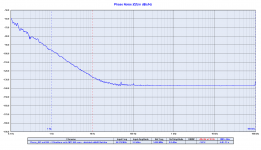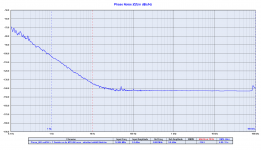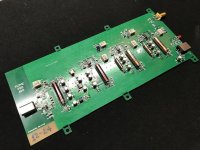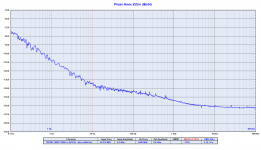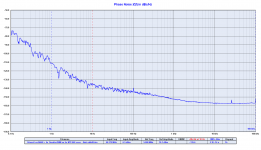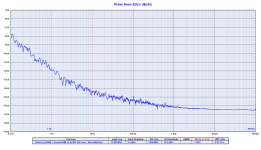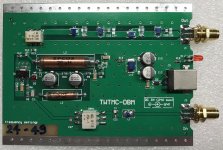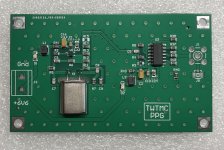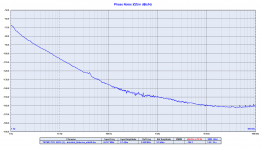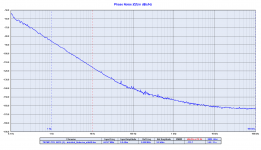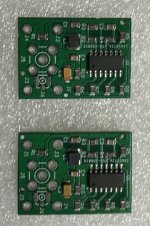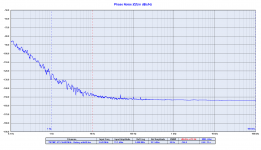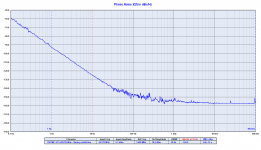This project is an impressive amount of work andrea_mori. I am trying to determine which parameters are important for achieving good phase noise. For example, I thought that good signal purity would a have role, but this does not seem to be the case. For example the Pierce gives a reasonable account for signal distortion and low noise seen at the crystal, but does not deliver best performance. Is this due to low circuit Q etc.
Have you formulated any views on what to prioritize? There isn't much clarity from technical papers either. I am developing a low current solution and determining whether the Pierce can be bettered in this role.
IMHO, the best solution is the Driscoll because the crystal is placed in the emitter circuit, the lowest impedance point of the circuit.
Although the Differential oscillator performs practically the same, only a little higher noise floor due (I believe) to the crystal placed in the feedback loop.
On the other side the Driscoll performs the best when the crystal has high ESR (100 ohm or more) because by the Ohm law the higher the ESR of the crystal the greater the loaded Q of the circuit.
And better using overtone crystals that offer very high unloaded Q.
A 3rd overtone SC-Cut crystal at 5MHz can reach a Q of 2M and more, its tipycal ESR is greter than 100 ohm, and so the loaded Q could reach 95/98% of the loaded Q.
The Pierce IMHO is more problematic, because in addition to the crystal in the feedback loop, its drive level depends on the load capacitance, so it's a little difficult to set the best drive level of the crystal.
And moreover the Pierce likes crystal with very low ESR, otherwise the loss in the feedback loop is huge and the oscilaltor does not start.
In a few words, you should choice the oscillator circuit as function of the crystal you have chosen.
Maybe the best oscillators for digital audio ever, at affordable prices
After several years of hard works we are glad to share our designs with the diy audio community.
Finally the tests, measurements and fine tunings are finished, we believe that any further improvement would be marginal.
Now it's time for interested users to try out the new devices in their audio chain.
We have developed oscillators, frequency doublers, LiFePo4 batteries power supply and so on thinking to the best possible performance, practically without compromise.
The new Driscoll (TWTMC-DRIXO) and Differential (TWTMC-EXO) oscillators are state of the art devices to be used as the master clock in digital to analog conversion.
The 5.6448 MHz oscillators are in the region of the Wenzel BT ULN and the Oscilloquartz BVA8607, the absolute references on the market.
These are the top of the line oscillators we have developed to be used in the top version of the whole audio system we are designing.
Even the LiFePo4 batteries power supply system (TWRPS-LBS) is part of the top line.
It's intended to supply almost all devices of the digital to analog chain (oscillators, sine to square converters, dividers and DAC), but could be used to supply whatever device that needs to be decoupled from the main AC.
Although we suggest batteries to supply oscillators, frequency doublers and squarers, we have developed a pair of low noise regulators (TWRPS-UGL and TWRPS-pp) as a cheaper alternative.
The new Pierce oscillator (TWTMC-PXO) has a few compromises against the top of the line and obviously its performance are not the same.
BTW, the 5/6 MHz perform very well considering thta they use AT-Cut crystals.
The Pierce can be used up to 45/49 MHz.
The frequency doubler (TWTMC-DBM) has impressive phase noise performance, by the measurement plots we have published it adds less than the theoretically 6dB for each multiplication.
It can be used in series (max 2 doublers) to reach 90/98 MHz.
When used with 5/6 (followed by 2 doublers) or 11/12 MHz (followed by one doubler) base oscillators the resulting 22/24 MHz output is really ultra low phase noise, better than the MSB Femto Seconds Galaxy Clock.
The combo Pierce oscillator TWTMC-PXO-AIO is a versatile device that can be used with 5/6 MHz AT-Cut crystals to provide very low phase noise outputs at 11/12 (-134 dbC at 10 Hz from the carrier) or 22/24 MHz (-127 dBc at 10 Hz from the carrier).
It also could be used to clock other devices like mother boards or switches at 24, 25 and 27 MHz starting from the base oscillator with crystals at 6, 6.25 and 6.75 MHz.
The sine to square converter little board TWTMC-STS performs very well, it substantially adds a little noise floor only to the sine wave oscillator, while the measured close in phase noise is almost superimposable to the phase noise of the oscillator to be squared.
It has be designed to fit Ian's FIFO boards.
Finally the new Pierce pico gate oscillator TWTMC-PPG is a entry level affordable oscillator at 22/24 MHz.
The price is similar to tha Crystek CCHD-597 and the measured phase noise is 10 to 20 dB better than the Crystek one.
BTW, it uses standard HC49 crystals so consistency of the phase noise performance cannot be guaranteed.
We also designed a few boards to be used with the Raspberry as the digital source: the TWSAFB-RPI proveides power supply for the RPI and the official 7" touch screen and isolated I2S output; the TWSAFB-TX and TWSAFB-RX are I2S LVDS transmitter and receiver to be used to place the RPI in a separate box far from the FIFO and the DAC (suggested).
Now we are working on the FIFO lite (TWSAFB-Lite) and on the discrete DAC lite (TWSDAC-LT) that will be parts of a future GB.
We decided to reduce the offer to 2 options:
- finished boards (fully assembled and tested)
- semi-finished boards (users have to solder a few parts, mostly TH)
We have eliminated the bare PCB option because the cost difference against the semi-finished option is very small (les than 10%), so it does not worth to assemble the whole board to save so little with greater risk of assembly errors.
I will publish soon al the documents for each device (final measurements, BOMs for semi-finished boards, assembly tips, user manual when requested).
Next days I will publish the Order Form with prices and conditions for all the boards that will be parts of the new GB and a sheet containing a comparative table between the costs of the 2 options (finished and semi-finished boards).
Stay tuned!
After several years of hard works we are glad to share our designs with the diy audio community.
Finally the tests, measurements and fine tunings are finished, we believe that any further improvement would be marginal.
Now it's time for interested users to try out the new devices in their audio chain.
We have developed oscillators, frequency doublers, LiFePo4 batteries power supply and so on thinking to the best possible performance, practically without compromise.
The new Driscoll (TWTMC-DRIXO) and Differential (TWTMC-EXO) oscillators are state of the art devices to be used as the master clock in digital to analog conversion.
The 5.6448 MHz oscillators are in the region of the Wenzel BT ULN and the Oscilloquartz BVA8607, the absolute references on the market.
These are the top of the line oscillators we have developed to be used in the top version of the whole audio system we are designing.
Even the LiFePo4 batteries power supply system (TWRPS-LBS) is part of the top line.
It's intended to supply almost all devices of the digital to analog chain (oscillators, sine to square converters, dividers and DAC), but could be used to supply whatever device that needs to be decoupled from the main AC.
Although we suggest batteries to supply oscillators, frequency doublers and squarers, we have developed a pair of low noise regulators (TWRPS-UGL and TWRPS-pp) as a cheaper alternative.
The new Pierce oscillator (TWTMC-PXO) has a few compromises against the top of the line and obviously its performance are not the same.
BTW, the 5/6 MHz perform very well considering thta they use AT-Cut crystals.
The Pierce can be used up to 45/49 MHz.
The frequency doubler (TWTMC-DBM) has impressive phase noise performance, by the measurement plots we have published it adds less than the theoretically 6dB for each multiplication.
It can be used in series (max 2 doublers) to reach 90/98 MHz.
When used with 5/6 (followed by 2 doublers) or 11/12 MHz (followed by one doubler) base oscillators the resulting 22/24 MHz output is really ultra low phase noise, better than the MSB Femto Seconds Galaxy Clock.
The combo Pierce oscillator TWTMC-PXO-AIO is a versatile device that can be used with 5/6 MHz AT-Cut crystals to provide very low phase noise outputs at 11/12 (-134 dbC at 10 Hz from the carrier) or 22/24 MHz (-127 dBc at 10 Hz from the carrier).
It also could be used to clock other devices like mother boards or switches at 24, 25 and 27 MHz starting from the base oscillator with crystals at 6, 6.25 and 6.75 MHz.
The sine to square converter little board TWTMC-STS performs very well, it substantially adds a little noise floor only to the sine wave oscillator, while the measured close in phase noise is almost superimposable to the phase noise of the oscillator to be squared.
It has be designed to fit Ian's FIFO boards.
Finally the new Pierce pico gate oscillator TWTMC-PPG is a entry level affordable oscillator at 22/24 MHz.
The price is similar to tha Crystek CCHD-597 and the measured phase noise is 10 to 20 dB better than the Crystek one.
BTW, it uses standard HC49 crystals so consistency of the phase noise performance cannot be guaranteed.
We also designed a few boards to be used with the Raspberry as the digital source: the TWSAFB-RPI proveides power supply for the RPI and the official 7" touch screen and isolated I2S output; the TWSAFB-TX and TWSAFB-RX are I2S LVDS transmitter and receiver to be used to place the RPI in a separate box far from the FIFO and the DAC (suggested).
Now we are working on the FIFO lite (TWSAFB-Lite) and on the discrete DAC lite (TWSDAC-LT) that will be parts of a future GB.
We decided to reduce the offer to 2 options:
- finished boards (fully assembled and tested)
- semi-finished boards (users have to solder a few parts, mostly TH)
We have eliminated the bare PCB option because the cost difference against the semi-finished option is very small (les than 10%), so it does not worth to assemble the whole board to save so little with greater risk of assembly errors.
I will publish soon al the documents for each device (final measurements, BOMs for semi-finished boards, assembly tips, user manual when requested).
Next days I will publish the Order Form with prices and conditions for all the boards that will be parts of the new GB and a sheet containing a comparative table between the costs of the 2 options (finished and semi-finished boards).
Stay tuned!
Special thanks
We didn't invent anything but we tried to learn from the real masters to develop state of the art devices, so special thanks to:
- George Washington Pierce (January 11, 1872 – August 25, 1956), the American Physicist inventor of the omonymous oscillator (the basis of TWTMC-PPG and TWTMC-PXO oscillators development).
G. W. Pierce - Wikipedia
- Michael M. Driscoll (Baltimore), the American Engineer inventor of the omonymous oscillator (the basis of TWTMC-DRIXO oscillator development).
https://www.linkedin.com/in/michael...issionId=ae3c240b-38e2-1916-0ee5-2b86dab28223
- Prof. Jeremy Kenneth Arthur Everard, RF Design Engineer Tsvetan Burtichelov and Keng Ng, University of York, the authors of Ultralow Phase Noise 10-MHz Crystal Oscillators (the basis of the TWTMC-EXO development).
Prof. Jeremy Kenneth Arthur Everard - Research Database, The University of York
Ultralow Phase Noise 10-MHz Crystal Oscillators - Research Database, The University of York
- Bruce Griffiths for his work on Driscoll oscillator and RF design (a great help on TWTMC-DRIXO and oscillators buffer development).
Bruce's Precision Time and Frequency Systems - KO4BB
https://nz.linkedin.com/in/bruce-griffiths-aa064a86 ?????
- Richard K. Karlquist (1951, Minneapolis, MN), American Engineer, for his work on frequency multiplyiing and division (a great help on TWTMC-DBM development).
http://www.karlquist.com/
- Enrico Rubiola (Italy, 1957), researcher with the Politecnico di Torino, guest professor with the University of Parma, Italy, and full professor with the University Henri Poincaré, Nancy, for his work on oscillator phase noise (a great help to understand and cure the phase noise in oscillator circuits).
http://rubiola.org/
- Pat Di Giacomo, the "master of clock", while all the people was discussing about the jitter (even measured with a bandwidth suitable for telecommunication devices) he was one of the first to point out the real issue, the close in phase noise of the master clock, the crucial importance of the timing error in the digital to analog conversion (our brain is also able to perceive temporal errors of femto seconds)
And mostly a very special thank to my co-developer Roberto A., who is a very very smart guy.
Without his help it would not have been possible to develop all these devices and with these performances.
We divided the work and we managed to develop all these projects.
We didn't invent anything but we tried to learn from the real masters to develop state of the art devices, so special thanks to:
- George Washington Pierce (January 11, 1872 – August 25, 1956), the American Physicist inventor of the omonymous oscillator (the basis of TWTMC-PPG and TWTMC-PXO oscillators development).
G. W. Pierce - Wikipedia
- Michael M. Driscoll (Baltimore), the American Engineer inventor of the omonymous oscillator (the basis of TWTMC-DRIXO oscillator development).
https://www.linkedin.com/in/michael...issionId=ae3c240b-38e2-1916-0ee5-2b86dab28223
- Prof. Jeremy Kenneth Arthur Everard, RF Design Engineer Tsvetan Burtichelov and Keng Ng, University of York, the authors of Ultralow Phase Noise 10-MHz Crystal Oscillators (the basis of the TWTMC-EXO development).
Prof. Jeremy Kenneth Arthur Everard - Research Database, The University of York
Ultralow Phase Noise 10-MHz Crystal Oscillators - Research Database, The University of York
- Bruce Griffiths for his work on Driscoll oscillator and RF design (a great help on TWTMC-DRIXO and oscillators buffer development).
Bruce's Precision Time and Frequency Systems - KO4BB
https://nz.linkedin.com/in/bruce-griffiths-aa064a86 ?????
- Richard K. Karlquist (1951, Minneapolis, MN), American Engineer, for his work on frequency multiplyiing and division (a great help on TWTMC-DBM development).
http://www.karlquist.com/
- Enrico Rubiola (Italy, 1957), researcher with the Politecnico di Torino, guest professor with the University of Parma, Italy, and full professor with the University Henri Poincaré, Nancy, for his work on oscillator phase noise (a great help to understand and cure the phase noise in oscillator circuits).
http://rubiola.org/
- Pat Di Giacomo, the "master of clock", while all the people was discussing about the jitter (even measured with a bandwidth suitable for telecommunication devices) he was one of the first to point out the real issue, the close in phase noise of the master clock, the crucial importance of the timing error in the digital to analog conversion (our brain is also able to perceive temporal errors of femto seconds)
And mostly a very special thank to my co-developer Roberto A., who is a very very smart guy.
Without his help it would not have been possible to develop all these devices and with these performances.
We divided the work and we managed to develop all these projects.
....
It also could be used to clock other devices like mother boards or switches at 24, 25 and 27 MHz starting from the base oscillator with crystals at 6, 6.25 and 6.75 MHz.....
8-o so you believe in that this is an application for a high performing clock... wow!
//
In the following posts I will publish all the infos about each device:
- features
- measurements
- BOMs for semi-finished boards
The BOM docs are Excel files that can be loaded directly on Mouser website to place the order with a few clicks.
The sheet named BOM contains all the parts to be ordered, while the sheet named XMFR contains the reference to the Mini-Circuits parts supplied separately.
The SMA connector (Mouser part 538-73251-1290) is very expensive, you can find a replacement like the following on eBay
10x SMA Female Jack Nut edge mount PC Board PCB receptacle RF Adapter Connector | eBay
Make sure they are the long type with nut and washer.
- features
- measurements
- BOMs for semi-finished boards
The BOM docs are Excel files that can be loaded directly on Mouser website to place the order with a few clicks.
The sheet named BOM contains all the parts to be ordered, while the sheet named XMFR contains the reference to the Mini-Circuits parts supplied separately.
The SMA connector (Mouser part 538-73251-1290) is very expensive, you can find a replacement like the following on eBay
10x SMA Female Jack Nut edge mount PC Board PCB receptacle RF Adapter Connector | eBay
Make sure they are the long type with nut and washer.
TWTMC-DRIXO new Driscoll oscillator
Oscillator type: Driscoll
Frequencies: 5.6448 MHz, 6.144 MHz, 11.2896 MHz, 12.288 MHz, 22.5792 MHz, 24.576 MHz
Output: sine wave (+16 dBm to +18 dBm)
Crystals: SC-Cut overtone only
Board size: 151mm x 75mm (excluding SMA connector)
Suitable box: Hammond 1455J1601 (Mouser part 546-1455J1601)
Board options: finished and semi-finished
Note: supplied without crystal and box
Oscillator type: Driscoll
Frequencies: 5.6448 MHz, 6.144 MHz, 11.2896 MHz, 12.288 MHz, 22.5792 MHz, 24.576 MHz
Output: sine wave (+16 dBm to +18 dBm)
Crystals: SC-Cut overtone only
Board size: 151mm x 75mm (excluding SMA connector)
Suitable box: Hammond 1455J1601 (Mouser part 546-1455J1601)
Board options: finished and semi-finished
Note: supplied without crystal and box
Attachments
-
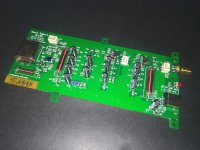 TWTMC-DRIXO.jpg793.9 KB · Views: 1,784
TWTMC-DRIXO.jpg793.9 KB · Views: 1,784 -
TWTMC-DRIXO-SF_Mouser_BOM.zip35.3 KB · Views: 453
-
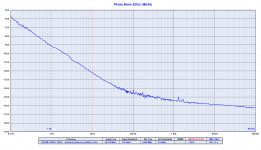 TWTMC-DRIXO 24576 - shielded_Batteries_att6dB_1h.png131.4 KB · Views: 484
TWTMC-DRIXO 24576 - shielded_Batteries_att6dB_1h.png131.4 KB · Views: 484 -
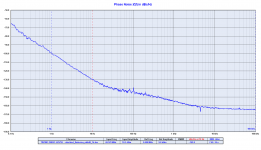 TWTMC-DRIXO 225792 - shielded_Batteries_att6dB_1h.png132.5 KB · Views: 1,544
TWTMC-DRIXO 225792 - shielded_Batteries_att6dB_1h.png132.5 KB · Views: 1,544 -
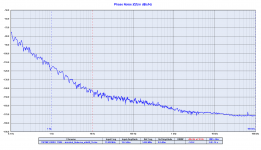 TWTMC-DRIXO 11286 - shielded_Batteries_att6dB_1h.png141.1 KB · Views: 1,542
TWTMC-DRIXO 11286 - shielded_Batteries_att6dB_1h.png141.1 KB · Views: 1,542 -
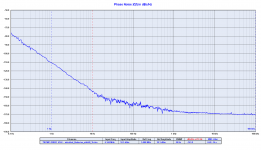 TWTMC-DRIXO 6144 - shielded_Batteries_att6dB_1h.png133.3 KB · Views: 1,901
TWTMC-DRIXO 6144 - shielded_Batteries_att6dB_1h.png133.3 KB · Views: 1,901 -
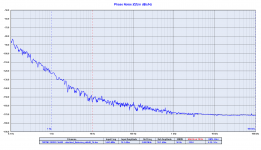 TWTMC-DRIXO 56448 - shielded_Batteries_att6dB_1h.png140.4 KB · Views: 1,768
TWTMC-DRIXO 56448 - shielded_Batteries_att6dB_1h.png140.4 KB · Views: 1,768
TWTMC-EXO new Differential oscillator
Oscillator type: Differential (York design based)
Frequencies: 5.6448 MHz, 6.144 MHz, 11.2896 MHz, 12.288 MHz, 22.5792 MHz, 24.576 MHz
Output: sine wave (+11 dBm to +16 dBm)
Crystals: SC-Cut overtone only
Board size: 151mm x 75mm (excluding SMA connector)
Suitable box: Hammond 1455J1601 (Mouser part 546-1455J1601)
Board options: finished and semi-finished
Note: supplied without crystal and box
Oscillator type: Differential (York design based)
Frequencies: 5.6448 MHz, 6.144 MHz, 11.2896 MHz, 12.288 MHz, 22.5792 MHz, 24.576 MHz
Output: sine wave (+11 dBm to +16 dBm)
Crystals: SC-Cut overtone only
Board size: 151mm x 75mm (excluding SMA connector)
Suitable box: Hammond 1455J1601 (Mouser part 546-1455J1601)
Board options: finished and semi-finished
Note: supplied without crystal and box
Attachments
-
TWTMC-EXO-SF_Mouser_BOM.zip36.6 KB · Views: 172
-
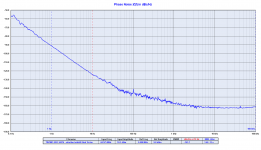 TWTMC-EXO 24576 - shielded att6dB Batt 1h.png133.6 KB · Views: 282
TWTMC-EXO 24576 - shielded att6dB Batt 1h.png133.6 KB · Views: 282 -
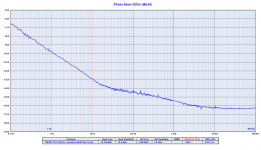 TWTMC-EXO 225792 - shielded att6dB Batt 1h.png132.1 KB · Views: 241
TWTMC-EXO 225792 - shielded att6dB Batt 1h.png132.1 KB · Views: 241 -
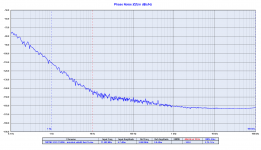 TWTMC-EXO 112896 - shielded att6dB Batt 1h.png134.7 KB · Views: 220
TWTMC-EXO 112896 - shielded att6dB Batt 1h.png134.7 KB · Views: 220 -
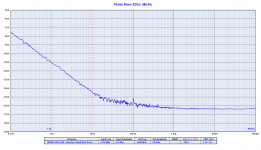 TWTMC-EXO 6144 - shielded att6dB Batt 1h.png131 KB · Views: 267
TWTMC-EXO 6144 - shielded att6dB Batt 1h.png131 KB · Views: 267 -
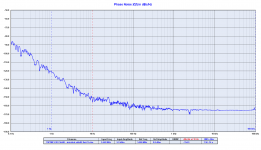 TWTMC-EXO 56448 - shielded att6dB Batt 1h.png137.7 KB · Views: 441
TWTMC-EXO 56448 - shielded att6dB Batt 1h.png137.7 KB · Views: 441 -
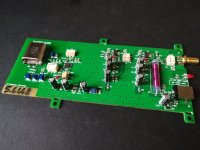 TWTMC-EXO.jpg311 KB · Views: 500
TWTMC-EXO.jpg311 KB · Views: 500
TWTMC-PXO new Pierce oscillator
Oscillator type: Pierce
Frequencies: 5.6448 MHz, 6.144 MHz, 11.2896 MHz, 12.288 MHz, 22.5792 MHz, 24.576 MHz, 45.1584 MHz, 49.152 MHz
Output: sine wave (+11 dBm to +12 dBm)
Crystals: AT-Cut only (fundamental and overtone)
Board size: 151mm x 75mm (excluding SMA connector)
Suitable box: Hammond 1455J1601 (Mouser part 546-1455J1601)
Board options: finished and semi-finished
Note: supplied without crystal and box
Oscillator type: Pierce
Frequencies: 5.6448 MHz, 6.144 MHz, 11.2896 MHz, 12.288 MHz, 22.5792 MHz, 24.576 MHz, 45.1584 MHz, 49.152 MHz
Output: sine wave (+11 dBm to +12 dBm)
Crystals: AT-Cut only (fundamental and overtone)
Board size: 151mm x 75mm (excluding SMA connector)
Suitable box: Hammond 1455J1601 (Mouser part 546-1455J1601)
Board options: finished and semi-finished
Note: supplied without crystal and box
Attachments
-
TWTMC-PXO-SF_Mouser_BOM.zip78.8 KB · Views: 131
-
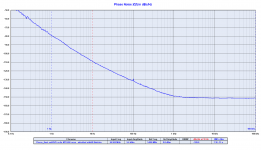 TWTMC-PXO Pierce 24576 - shielded att6dB Batt.png126.8 KB · Views: 264
TWTMC-PXO Pierce 24576 - shielded att6dB Batt.png126.8 KB · Views: 264 -
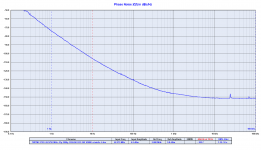 TWTMC-PXO Pierce 225792 - shielded att6dB Batt.png126.6 KB · Views: 216
TWTMC-PXO Pierce 225792 - shielded att6dB Batt.png126.6 KB · Views: 216 -
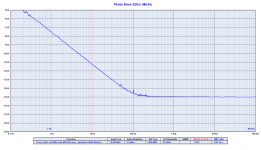 TWTMC-PXO Pierce 12288 - shielded att6dB Batt.png126.2 KB · Views: 205
TWTMC-PXO Pierce 12288 - shielded att6dB Batt.png126.2 KB · Views: 205 -
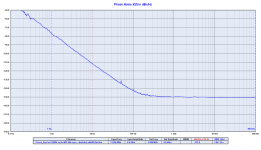 TWTMC-PXO Pierce 112896 - shielded att6dB Batt.png126.1 KB · Views: 211
TWTMC-PXO Pierce 112896 - shielded att6dB Batt.png126.1 KB · Views: 211 -
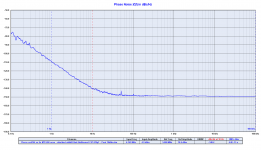 TWTMC-PXO Pierce 6144 - shielded att6dB Batt.png126.5 KB · Views: 253
TWTMC-PXO Pierce 6144 - shielded att6dB Batt.png126.5 KB · Views: 253 -
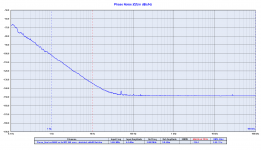 TWTMC-PXO Pierce 56448 - shielded att6dB Batt.png125 KB · Views: 399
TWTMC-PXO Pierce 56448 - shielded att6dB Batt.png125 KB · Views: 399 -
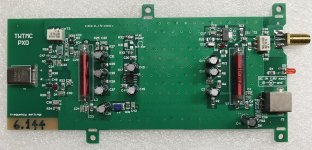 TWTMC-PXO.jpg226.5 KB · Views: 380
TWTMC-PXO.jpg226.5 KB · Views: 380
TWTMC-PXO-AIO new Pierce combo oscillator & frequency doublers
Oscillator type: Pierce
Frequencies: 11.2896 MHz, 12.288 MHz, 22.5792 MHz, 24.576 MHz
Output: sine wave (+10 dBm to +11 dBm)
Crystals: AT-Cut only (5.6448 MHz and 6.144 MHz)
Board size: 211mm x 100mm (excluding SMA connector)
Suitable box: Hammond 1455L2201 (Mouser part 546-1455L2201)
Board options: finished and semi-finished
Note: supplied without crystal and box
Oscillator type: Pierce
Frequencies: 11.2896 MHz, 12.288 MHz, 22.5792 MHz, 24.576 MHz
Output: sine wave (+10 dBm to +11 dBm)
Crystals: AT-Cut only (5.6448 MHz and 6.144 MHz)
Board size: 211mm x 100mm (excluding SMA connector)
Suitable box: Hammond 1455L2201 (Mouser part 546-1455L2201)
Board options: finished and semi-finished
Note: supplied without crystal and box
Attachments
The SMA connector (Mouser part 538-73251-1290) is very expensive...
Mouser is showing a price for that part number of: $6.94/ea
TWTMC-DBM new frequency doubler
Oscillator Frequencies: 5.6448 MHz, 6.144 MHz, 11.2896 MHz, 12.288 MHz, 22.5792 MHz, 24.576 MHz
Output: sine wave (+10 dBm to +15 dBm)
Output Frequencies: base oscillator frequency x 2 or x 4 (series of 2)
Board size: 99mm x 75mm (excluding SMA connector)
Suitable box: Hammond 1455J1201 (Mouser part 546-1455J1201)
Board options: finished and semi-finished
Note: max 2 doublers in series, supplied without box
Oscillator Frequencies: 5.6448 MHz, 6.144 MHz, 11.2896 MHz, 12.288 MHz, 22.5792 MHz, 24.576 MHz
Output: sine wave (+10 dBm to +15 dBm)
Output Frequencies: base oscillator frequency x 2 or x 4 (series of 2)
Board size: 99mm x 75mm (excluding SMA connector)
Suitable box: Hammond 1455J1201 (Mouser part 546-1455J1201)
Board options: finished and semi-finished
Note: max 2 doublers in series, supplied without box
Attachments
TWTMC-PPG new Pierce pico gate oscillator
Oscillator type: Pierce (entry level)
Frequencies: 22.5792 MHz, 24.576 MHz
Output: square wave (+15 dBm)
Crystals: AT-Cut fundamental only
Board size: 81mm x 48mm
Board options: finished only
Note: supplied with crystal on board
Oscillator type: Pierce (entry level)
Frequencies: 22.5792 MHz, 24.576 MHz
Output: square wave (+15 dBm)
Crystals: AT-Cut fundamental only
Board size: 81mm x 48mm
Board options: finished only
Note: supplied with crystal on board
Attachments
TWTMC-STS sine to square converter
Oscillator Frequencies: 5.6448 MHz to 98.304 MHz
Output: square wave (+15 dBm)
Board size: 81mm x 48mm
Board options: finished only
Note: supplied without connectors, to be used with Ian's FIFO
Oscillator Frequencies: 5.6448 MHz to 98.304 MHz
Output: square wave (+15 dBm)
Board size: 81mm x 48mm
Board options: finished only
Note: supplied without connectors, to be used with Ian's FIFO
Attachments
Raspberry interfaces
Please, see the dedicated thread at
The Well synchronized asynchronous FIFO buffer - Slaved I2S reclocker
Please, see the dedicated thread at
The Well synchronized asynchronous FIFO buffer - Slaved I2S reclocker
- Status
- Not open for further replies.
- Home
- Source & Line
- Digital Line Level
- The Well Tempered Master Clock - Building a low phase noise/jitter crystal oscillator
